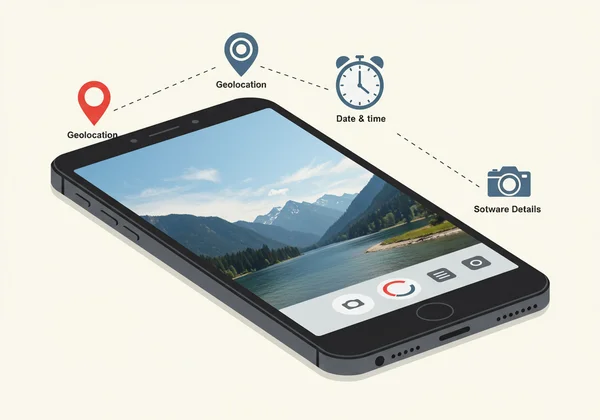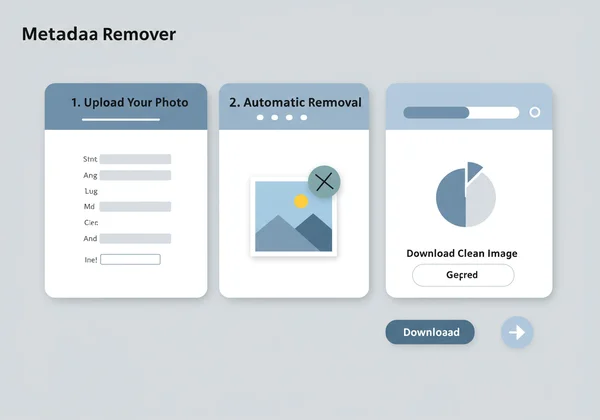Remove Photo Metadata: Avoid Privacy Disasters with Our Free Remover
The photos you share online tell more than just a visual story. Hidden within every digital image lies a trove of "photo metadata" – invisible data that can reveal intimate details about your life, location, and even your devices. While often harmless, ignoring this hidden information can lead to a serious metadata privacy breach. Do you know what sensitive data your photos are revealing to the world?

We'll uncover five chilling real-world metadata risks and show you how to easily protect yourself. The power to control your digital footprint is simpler than you think, and it starts with understanding what your images are secretly saying. Before your next post, learn how a free metadata remover can safeguard your privacy.
Unmasking the Invisible: What is Photo Metadata & Why it Matters
Before diving into the dangers, it’s crucial to understand the hidden culprit. Photo metadata, most commonly known as EXIF (Exchangeable Image File Format) data, is a set of information automatically embedded into every picture you take with a digital camera, smartphone, or tablet.
Think of it as a digital label attached to your image file. This label contains technical details like camera settings, but it can also include deeply personal information. The real issue isn't the data itself, but how easily it travels with your photo, becoming instantly accessible to anyone online who knows where to look. But you can stop it.
More Than Just a Photo: Types of EXIF Data to Watch Out For
This isn't just about the make and model of your camera. The hidden information in your photos can be alarmingly specific. Key types of EXIF data that pose a privacy risk include:
-
Geolocation Data (GPS): The exact latitude and longitude where the photo was taken. This can pinpoint your home, office, your child's school, or your favorite vacation spot.
-
Date and Time: The precise date and time the image was captured, which can reveal your daily routines and schedules.
-
Device Information: The specific model of your camera or smartphone, including its unique serial number in some cases.
-
Software Details: Information about the software used to view or edit the photo, which can sometimes reveal your operating system and software versions.

The Silent Threat: How Geotagging & Other Data Can Expose You
The most immediate danger comes from geotagging. When you post a photo of your new laptop on your desk at home, you might also be broadcasting your exact home address. When you share a picture from your vacation, you could be telling burglars that your house is currently empty.
This isn't theoretical fear-mongering; it's a digital reality. Malicious actors, from stalkers to sophisticated criminals, can aggregate this data from various photos to build a detailed profile of your life—where you live, where you work, when you're away, and what valuable items you own. It’s time to take control and erase exif data before you share.
Real-World Privacy Disasters: 5 Times Metadata Went Horribly Wrong

These scenarios illustrate the severe consequences of overlooking photo metadata. They are prime exif data leak examples that show how a simple picture can turn into a significant security threat.
Disaster 1: Geolocation Leaks Leading to Stalking & Burglaries
A travel blogger excitedly shared photos from her two-week trip to Bali. Her posts, filled with beautiful scenery, also contained precise GPS coordinates embedded in the metadata. A criminal group monitoring social media for such cues used the geotags from her "leaving for the airport" photo and the timestamps from her vacation posts to confirm she was away. They pinpointed her home address from older photos she had posted from her living room and burglarized her apartment, stealing electronics and valuables. This is one of the most common geotagging dangers, turning a cherished memory into a traumatic event.
Disaster 2: Exposing Whistleblowers & Confidential Information
In a high-profile case, an anonymous source leaked photos of a sensitive corporate document to a journalist to expose wrongdoing. However, the source used their personal smartphone to take the picture. The metadata contained the phone's model and, crucially, the date and time. Investigators from the corporation were able to cross-reference this information with employee access logs, drastically narrowing down the list of potential whistleblowers and ultimately identifying the person, who faced severe legal and professional repercussions. This demonstrates how metadata can undermine attempts at anonymity and jeopardize secure photo sharing.
Disaster 3: Unwittingly Revealing Home Addresses and High-Value Assets
Someone trying to sell a vintage watch online took a high-quality photo to post on a marketplace forum. The photo, taken inside his home office, had metadata that included the GPS coordinates of his house. A potential "buyer" used this data to find his address, and instead of purchasing the watch, targeted him for a home invasion, knowing the specific high-value asset he owned. This is a stark reminder that even a single photo can compromise your physical security. You can easily remove image metadata to prevent this.
Disaster 4: Device Data & Personal Habits Shared Unknowingly
A photography enthusiast regularly posted her work in online forums. The EXIF data on her photos consistently showed she was using a new, expensive camera model. It also revealed the exact times she would go to a nearby park to shoot photos in the early morning. A thief, active on the same forums, used this information to track her routine. Knowing her schedule and the valuable equipment he carried, they confronted and robbed her at the park one morning. Her digital footprint had inadvertently made her a predictable target.
Disaster 5: Jeopardizing Personal Safety and Privacy on Social Media
A proud parent frequently posted photos of their child at the local playground on a private but large social media group. Many of the photos contained geotags. Another member of the group, who had malicious intent, was able to use the metadata from multiple photos to determine the exact park, the specific days of the week, and the times the parent and child visited. This created a terrifying stalking risk, all stemming from innocently shared pictures. Protecting your family’s privacy is paramount, and a quick meta cleaner is an essential first step.
Your Shield Against Exposure: How to Prevent a Metadata Privacy Breach
Seeing these real-world metadata risks is alarming, but the solution is incredibly simple. You don't need to stop sharing photos; you just need to share them safely. Protecting yourself from a metadata privacy breach requires a simple, proactive step before you click "post."
Simple Steps to Safeguard Your Image Privacy Before Sharing
The most effective way to protect yourself is to strip all metadata from your photos before they ever reach the internet. While some social media platforms claim to remove metadata, this isn't always consistent, and it doesn't protect you when sharing photos via email, messaging apps, or on personal blogs and forums. Manually disabling geotagging on your phone is a good start, but it doesn't remove other sensitive data like device information and timestamps. The only guaranteed method is to use a dedicated tool to wipe the data clean.
Instant Protection: Remove Metadata with Our Free Online Tool
The easiest and most secure way to safeguard your privacy is by using an online tool designed for this exact purpose. Our free online tool offers a seamless, three-step solution to this complex problem:
-
Upload Your Photo: Simply drag and drop your image onto the website.
-
Automatic Removal: The tool instantly processes your image, stripping away all EXIF data in seconds.
-
Download the Clean Image: Download the privacy-safe version of your photo, ready to be shared anywhere.

The entire process happens without storing your images, ensuring your photos remain your own. It's a completely free, anonymous, and fast way to remove metadata from photo files, giving you total peace of mind.
Don't let your cherished memories become a privacy nightmare. The invisible data in your photos carries significant and often overlooked dangers. Understanding the real-world metadata risks, from geotagging that leads to burglaries to data that exposes personal routines, is the first critical step.
Taking action is the next. You don't need technical expertise to protect yourself. With a straightforward and secure solution, safeguarding your images from the kind of exif data leak examples we've discussed is effortless. Before you share another picture, take a few seconds to clean it. Protect your privacy, secure your data, and share with confidence. Try our free tool today and take control of your digital story.
Frequently Asked Questions About Photo Metadata Risks
What exactly is metadata in a photo, and what can it reveal?
Photo metadata, or EXIF data, is text information embedded in an image file. It can reveal a surprising amount about you, including the precise GPS location where the photo was taken, the date and time, the specific camera or smartphone model used, and even camera settings. This data can be used to track your movements, learn your habits, and identify your personal property.
Why is it important to remove metadata from images before sharing them?
Removing metadata is crucial for protecting your privacy and security. It prevents stalkers, burglars, or other malicious actors from discovering your location, schedule, and other sensitive personal details. For professionals, it protects client confidentiality and proprietary information. In short, stripping metadata ensures you are only sharing the picture, not your private data.
How do I remove metadata from my photos easily and safely?
The safest and simplest method is to use a trusted online tool. A service like our online metadata remover allows you to upload your photo, automatically removes all metadata in seconds, and then lets you download the clean file. Crucially, trusted services do not store your images, ensuring your privacy is protected throughout the process.
Can metadata removal affect my photo quality?
No, removing metadata does not affect the visual quality of your photo at all. The process only strips the invisible text data from the file, leaving the image pixels completely untouched. Your photo will look exactly the same, but it will be much safer to share online. You can confidently clean your photos without worrying about degrading their quality.